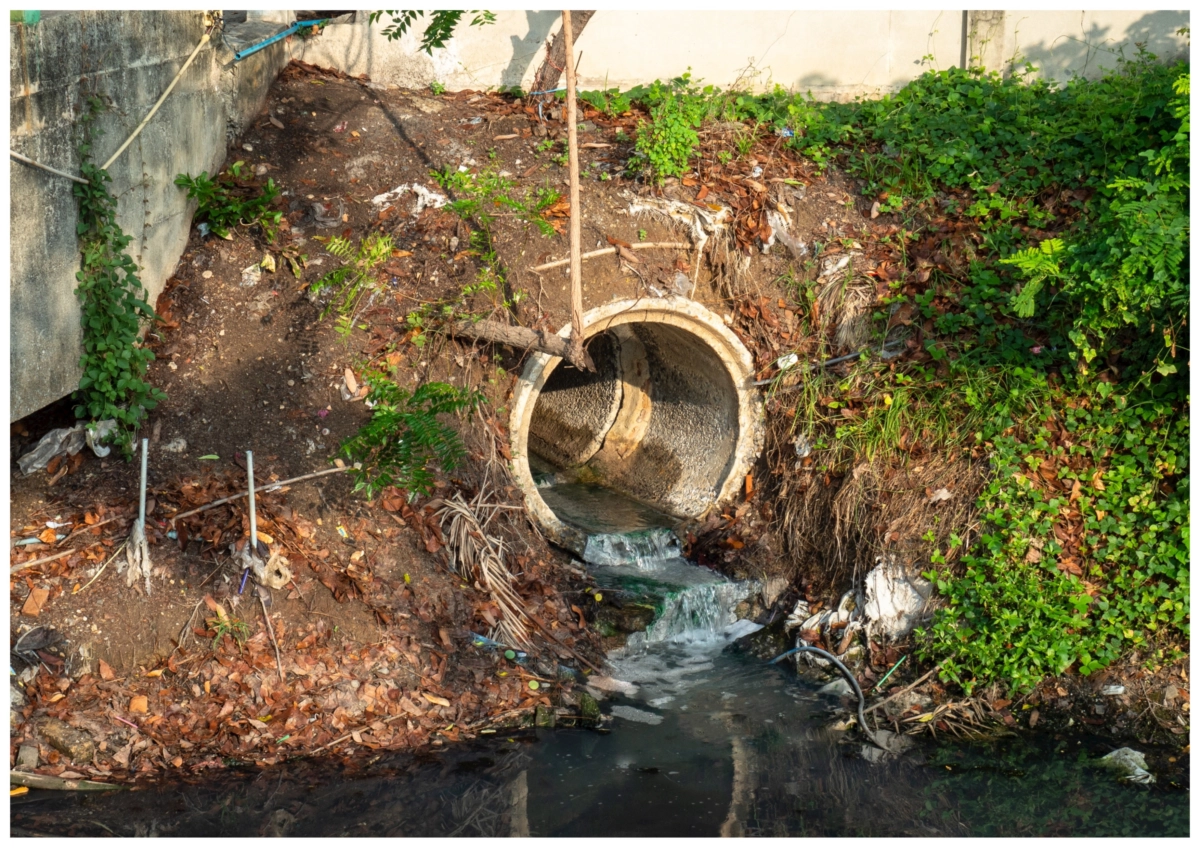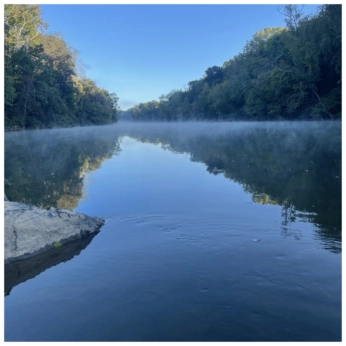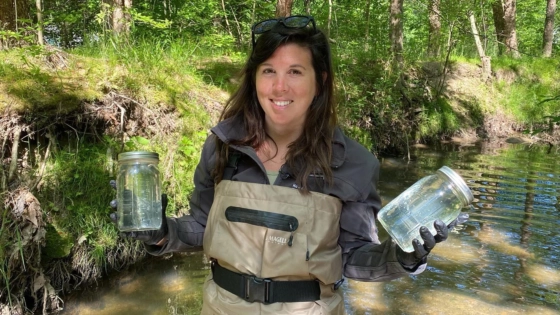A new report from Food & Water Watch analyzed why attempts to legally rein in "forever chemicals" continue to fail.

The Haw River cuts through North Carolina’s Piedmont region from its source in Forsyth County. Below Jordan Lake, it joins the Deep River to form the Cape Fear River, which empties into the Atlantic Ocean near the southernmost tip of the state.
“Haw River watershed is beautiful,” says Emily Sutton, Haw Riverkeeper for the Haw River Assembly. “It’s really rocky. There’s some high bluffs and fun rapids to paddle and lots of hikes—it’s [a] very accessible river.”
The river is undeniably beautiful. But per- and polyfluoroalkyl substances, commonly abbreviated as PFAS, are not visible to the naked eye. PFAS are chemicals that have been linked to debilitating health effects in high concentrations, and they are now so widespread that they are found in the blood of 97 percent of Americans.
This year, the EPA issued a proposed rule that public drinking water systems should not have more than four parts per trillion of two PFAS compounds, PFOS and PFOA. Back in 2019, Sutton and the Haw River Assembly detected 30,000 parts per trillion of total PFAS coming into the Haw from the city of Burlington—7,500 times the maximum concentration in the proposed new guidelines. For communities downstream that get their drinking water from the Haw, such as the town of Pittsboro, this invisible danger was a direct threat. The drinking water technically met all state quality standards, but only because there weren’t any for PFAS. The Haw River Assembly, the Southern Environmental Law Center and community members sprang into action.
A global pollution problem, communities such as those along the Haw River are having to deal with the reality of PFAS. While some states, such as Maine and New York, have passed laws beginning to regulate PFAS, federal oversight remains very light on these chemicals. Meanwhile, a new report from Food & Water Watch digs into why exactly these substances remain largely unregulated.

The Haw River. (Photography by Emily Sutton)
What are PFAS and when did they become a problem?
PFAS are chemicals that have been used commercially since the 1940s. They all contain a bond between the chemical elements carbon and fluorine, the strength of which keeps them from breaking down, giving them the nickname “forever chemicals.” Because these chemicals are so hardy, they bioaccumulate, meaning they grow in concentration over time. They are so widespread that they are found around the world. They are in Teflon pans, rain gear and mascara. They are in firefighting foam, electronics and hand sanitizer. They are in our blood.
The term PFAS refers to a class of chemicals that includes thousands of substances—as many as 14,000 or 15,000. “Part of the problem is that we can only test for about 70 of these 14,000,” said Kyla Bennett, director of Science Policy at Public Employees for Environmental Responsibility (PEER), in a recent Food & Water Watch webinar. “So, we don’t even know the chemical formulas of the vast number of these PFAS that are out there.”
PFAS are not naturally occurring—they have historically been made by a few key corporations, such as DuPont and 3M.
The industry has known of the chemicals’ toxicity since very early in their use, said Natalie Balbuena, researcher for Food & Water Watch, in the webinar. The public didn’t know about PFAS until 1999, when a case was brought to the courts arguing that a farmer who lived near a DuPont plant noticed his cattle were dying.
“From there, all the information came out, and people started to really pay attention,” said Balbuena. Since then, high-profile cases have been brought against PFAS manufacturers, including one that resulted in a $671-million settlement in 2017 on behalf of West Virginians near the DuPont Washington Works plant, who were experiencing a myriad of health problems, from birth defects to cancer.
[RELATED: You’ve Already Been Exposed to Toxic PFAS. But You Can Take Steps to Minimize Future Exposure]
When it comes to agriculture, the cattle farmer near the DuPont plant was not a PFAS anomaly. A report from FoodPrint says that agricultural land across the country could be compromised. PFAS from contaminated water and topically applied biosolids, or “sludge,” can result in PFAS uptake for both animal agriculture and produce. This means that PFAS is also a growing concern for the food system—both for consumers and for farmworkers who work on contaminated land.
“‘Biosolids’ is just a euphemism for human sewage sludge,” said Bennett. Once wastewater passes through a treatment plant, the substance left over has commonly been applied to agricultural fields as fertilizer. “Turns out, the biosolids or the sewage sludge has a ton of PFAS in it, and farmers all across the country have been applying the sewage sludge to their farms and their fields.”
The resulting contamination has shut down farms across the country. Fortunately, there are some mechanisms for farm recovery. Even so, PFAS remains a concern at every level of the food system, from agriculture to cooking in the kitchen.
The public has now known about PFAS for more than 20 years, but it’s taken until this year for the EPA to propose drinking water standards. In 2023, the EPA proposed regulated maximum contaminant levels (MCLs) for a small handful of PFAS in public drinking water. This means public drinking water systems would be regularly tested for compliance. A decision on this proposed rule is expected soon.
“Is it enough?” said Bennett. “Absolutely not.”
In the Haw Rivershed
When Emily Sutton of the Haw River Assembly samples for PFAS in her watershed, she identifies potential sources of pollution on maps and how she can get to them without trespassing.
“Oftentimes, that means we’re in boats paddling up the river to make sure that we can get as close to the pipe as possible,” says Sutton.
Wearing waders and gloves, Sutton will take sample jars over to the effluent pipe outfall and collect a sample directly from the source. She sends the samples to a lab and awaits the results.
In 2019, when the Haw River Assembly detected startlingly high levels of PFAS in an effluent pipe flowing into the Haw River, they immediately began alerting the public. The Haw River Assembly, along with the Southern Environmental Law Center, filed an intent to sue the city of Burlington. They also sent out mailers and calls to residents and held community meetings. They were able to negotiate a settlement with the city that targeted the industrial sources of PFAS, and got them to change their practices by phasing out PFAS elements or reducing their use.
“So, what used to be 30,000 parts per trillion coming from their wastewater effluent into the Haw is now consistently under 500,” says Sutton. “And it’s getting lower as that minimization plan is carried out.”

Haw Riverkeeper Emily Sutton samples water in the Haw Rivershed. (Photography by Liz McLaughlin)
Blocking legislation
Bennett said in the weinar that the EPA needs to define PFAS broadly, regulate them as a class and then ban all non-essential uses.
“Unless you can define something, you can’t regulate it,” says Bennett. “We don’t need PFAS in our mascara. That’s a convenience, not a necessity.”
It’s not for lack of trying. In the new report for Food & Water Watch, Balbuena analyzes the attempts at regulation. Between 2021 and 2022, more than 70 bills that addressed PFAS were introduced to the US Congress. But the industry has so much influence, says Balbuena, that lobbying on behalf of PFAS has been very effective at keeping legislation at bay. Only four of the bills mentioning PFAS between 2019 and 2022 ever became law.
Lobbyists against PFAS regulation represent major PFAS manufacturers, oil and petroleum companies and the American Chemistry Council. For example, for eight current and historic major PFAS manufacturers between 2019 and 2022, lobbying reports totaling $55.7 million included content on PFAS and related bills, among other issues.
These lobbyists target bills that would regulate PFAS, such as the PFAS Action Act, introduced in both 2019 and 2021. The report looked at eight PFAS manufacturers and noted that those companies employed 28 lobbyists to fight against the bill in 2019.
Additionally, Food & Water Watch found that in the US Senate Committee on Environment and Public Works—the same committee that failed to pass the PFAS Action Act—PFAS manufacturers contributed funds to the campaigns of two-thirds of the committee members. Committee members also received financial support from oil and gas companies and from the American Chemistry Council, all of which have an interest in PFAS remaining unregulated.
“There’s a lot of things here that tell us just how much influence the industry has with its money,” says Balbuena.
PFAS work on the ground
Across the country, communities are becoming more aware of PFAS and taking steps to address contamination. Several states, including Vermont and Michigan, have sued PFAS manufacturers. Many states have also passed their own regulations, in lieu of federal standards. River and waterkeepers across the country, as well as other advocacy groups, keep an eye on local communities, staying vigilant.
As it flows downstream, the Haw River eventually joins the Cape Fear River and carries on until it empties into the Atlantic Ocean near the southern tip of the state. The Cape Fear River basin supplies drinking water for nearly one million people.

The Cape Fear River in Wilmington, NC. (Photo: Shutterstock)
In 2017, Wilmington’s StarNews broke the story about contamination from a PFAS called GenX in the Cape Fear River from the company Chemours.
“That was kind of the beginning of all of our knowledge-seeking on what GenX is, number one, and what PFAS is and what it means to us,” says Dana Sargent, executive director at Cape Fear River Watch.
Sargent has been heavily involved in PFAS work. Since there are no official regulations for PFAS in public drinking water systems in North Carolina, CFRW and the Southern Environmental Law Center sued Chemours and the North Carolina Department of Environmental Quality. This resulted in a consent order among the three entities. Under the consent order, Chemours has to find standards for the more than 250 types of PFAS coming from its plant. It’s a long and slow process, but, she says, the impact is hugely important.
The best-case scenario, says Sargent, is a world where we no longer produce PFAS. But the amount of money the chemical industry makes off of PFAS prevents meaningful steps toward alternatives.
“We need to find a better way,” says Sargent. “We need to do better science, to stop putting PFAS out into the environment, because we know once it’s out there, it doesn’t go away.”
***
Read the full report: You can read Food & Water Watch’s full report here.
Watch to learn: If you want to learn more, the documentary “The Devil We Know,” about how PFAS contamination has rocked communities in West Virginia, is a good place to start. Then, watch “Dark Waters,” a film based on the true story of Robert Bilott, the lawyer who went up against chemical company DuPont.
Decrease your exposure: We solicited insights from those interviewed for this story about what people can do to decrease their risk of exposure to PFAS. Read some of their recommendations here.
Your article does not mention EPA’s Unregulated Contaminant Monitoring Rule (UCMR) whereby constituents on the watchlist for future regulation must be measured by thousands of water utilities across the US, and includes for 2024 the handful of PFAS that your article notes. Results will be used to determine the number of water utilities that will need to install expensive controls to meet VERY STRICT (at the current ability to detect!) Maximum Contaminant Level (MCL) proposed and thus to estimate the nationwide cost of compliance. The larger water utilities having already by monitoring PFAS for at least several years, the best… Read more »